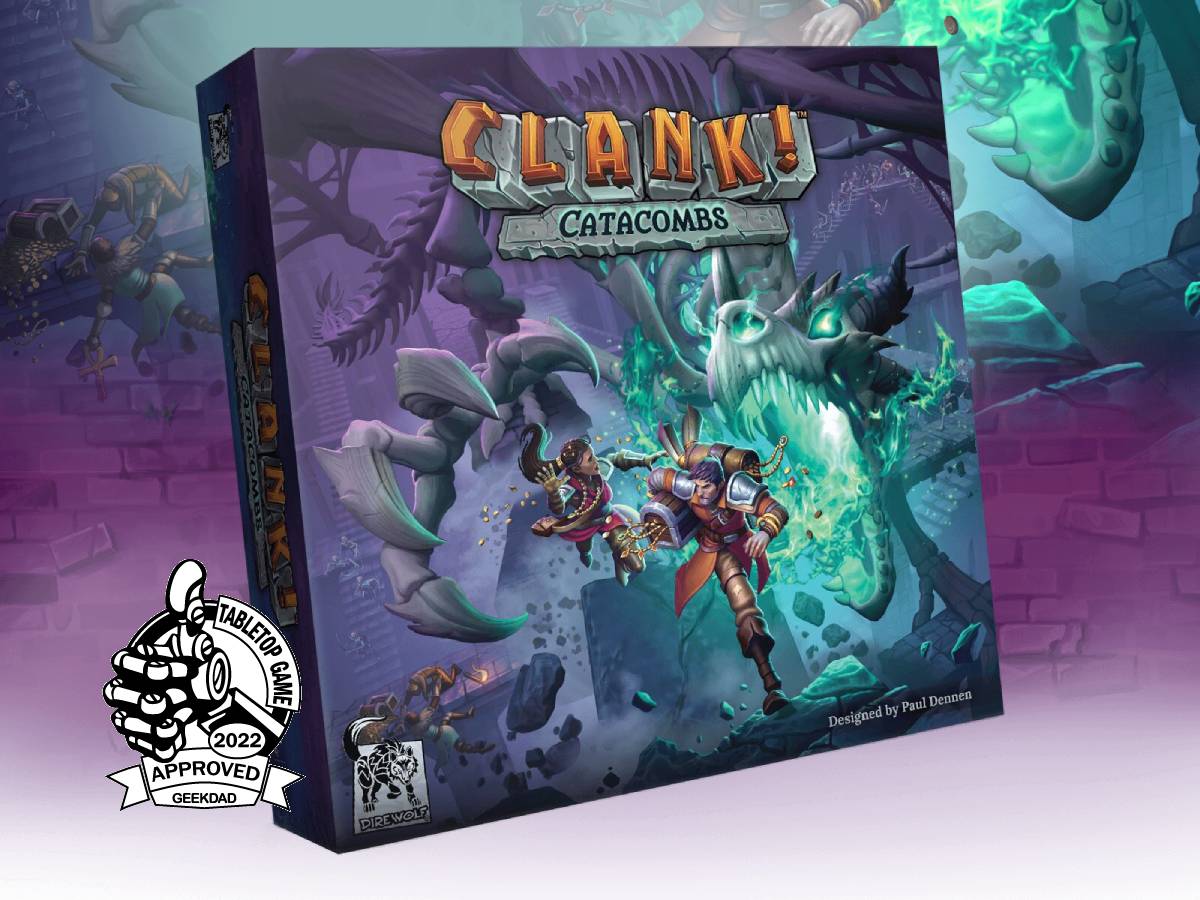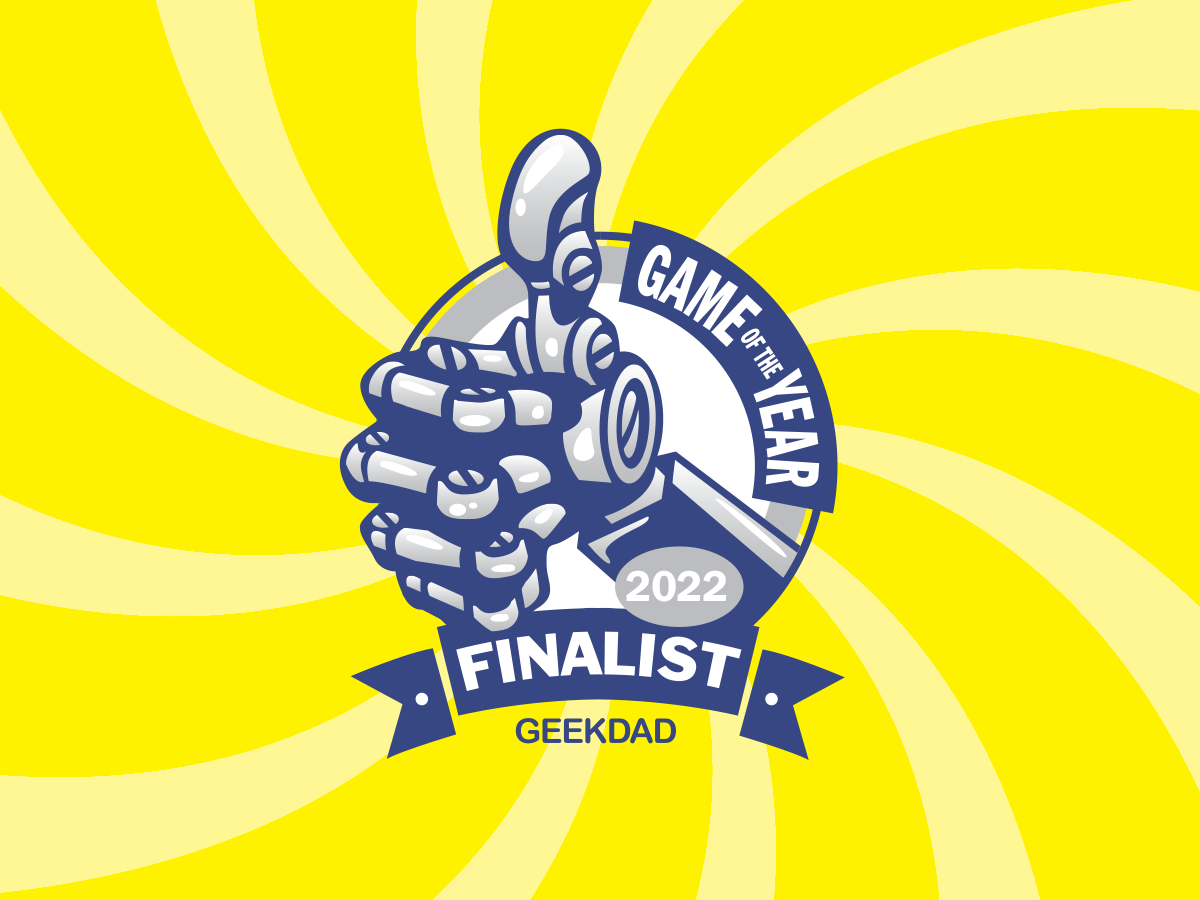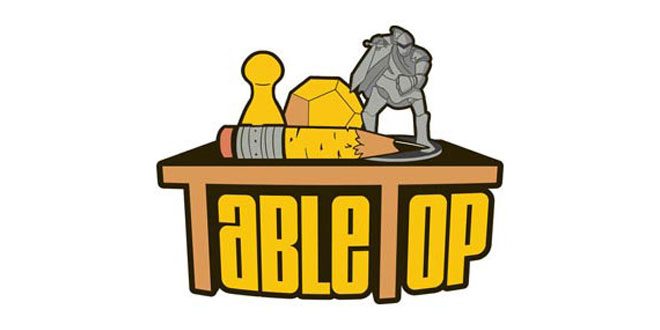Strap on your armor and your best sneaking boots, and head down into the dungeon to steal some of the dragon’s treasure. But this dungeon holds even more secrets than you had imagined…
What Is Clank! Catacombs?
Clank! Catacombs is a standalone deckbuilding game in the Clank! series. Previously, Clank! In! Space! was the winner of the 2017 GeekDad Tabletop Game of the Year. Clank! Catacombs is a game for 2-4 players, ages 13 and up, and takes about 45-90 minutes to play. It will be available later this month, with a retail cost of $60. You can keep your eye out on Amazon or the Dire Wolf website for when the game will be available in stores. While the content of the game is definitely family-friendly, some of the card interactions could get a little complicated for younger kids so it’s likely best with teens and adults as recommended by Dire Wolf.
Clank! Catacombs was designed by Paul Dennen and published by Dire Wolf, with illustrations by Clay Brooks, Anika Burrell, Nate Storm, and Dan Taylor.

Clank! Catacombs Components
Here is what’s inside the box:
- 29 Dungeon Tiles
- Clank! Board
- 180+ Cards
- 140+ Punch Tokens
- Market Board
- 30 Cubes and 1 Players Marker, each in 4 player colors
- 24 Dragon Cubes
- 5 Ghost Cubes
- Cloth Dragon Bag
- Dragon Marker
- Rules
If you’ve ever played any of the previous games in the Clank! series, then a lot of the components will look familiar to you, despite some changes in graphic design for this game.
The Clank! Board has wound tracks for the four players, as well as a track on the side to show the current “rage level” of the Dragon. As players acquire artifacts or dragon eggs, the Dragon’s rage will increase. When players make noise or “clank,” they place one of their cubes into the space where the Clank! Catacombs title resides.

Another staple of the Clank! series is the Market Board. When your meeple is in a marketplace space, you can then buy any of the available tokens from the Market for 7 gold.

In the very first Clank! game, 2016’s Clank!: A Deck Building Adventure, there was a double-sided game board presenting two different maps that you could play on. With Clank! In! Space!, the game board was modular, with 7 pieces that you could mix and match for gameplay variety.
In Clank! Catacombs, there is no game board. Instead, you’ll have individual tiles that will get shuffled and placed as players explore the dungeon. Each of these tiles can be oriented in whichever way the current player chooses. And some game effects can even cause tiles to rotate after they’re placed.
The purplish tiles are “Safety” tiles, where players can still score even if they get knocked out of the game. The majority of the tiles are blue “Depths” tiles. If you get knocked out on one of those, you’re out of the game for good.
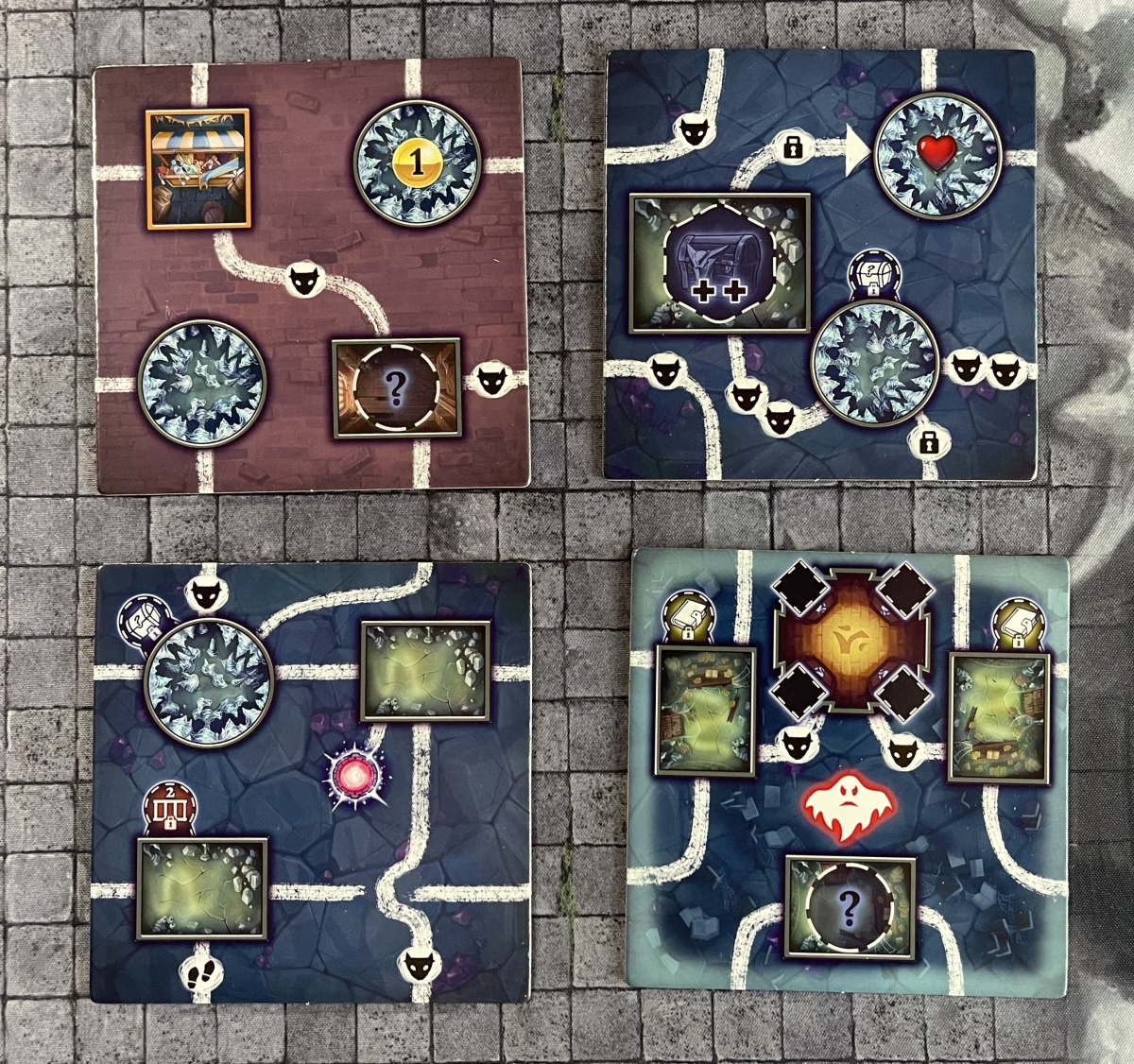
As with other games in the Clank! universe, player components are wooden. In addition to wooden cubes, players will choose different adventurers. There is no practical difference between the adventurers; you just choose the color you like best. The dragon meeple marks the progress on the rage track.
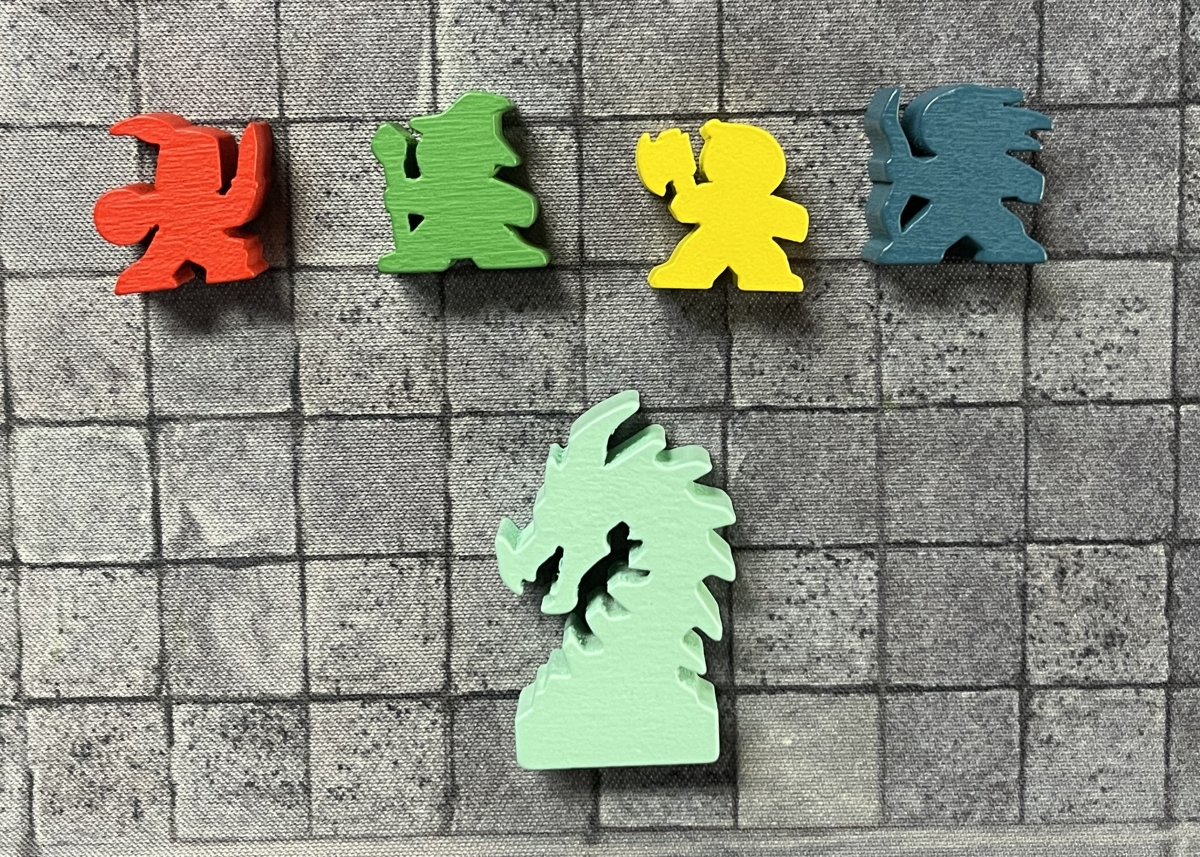
The dragon gets his own bag, which is used to randomize wounds for when the dragon attacks. When the dragon periodically attacks, any cubes in the Clank! area will get moved into the dragon bag, shuffled, and a certain number get drawn, which may result in wounds for different players.

One of the new features introduced in this game are lockpicks. There is no longer a master key that you can purchase from the marketplace. Instead, players will all start with a set of lockpicks. These lockpicks will permanently open locked passages in the dungeon, and can also be used to open up other features.

The Prisoners are another new token, and a way to gain in-game benefits or endgame scoring bonuses.
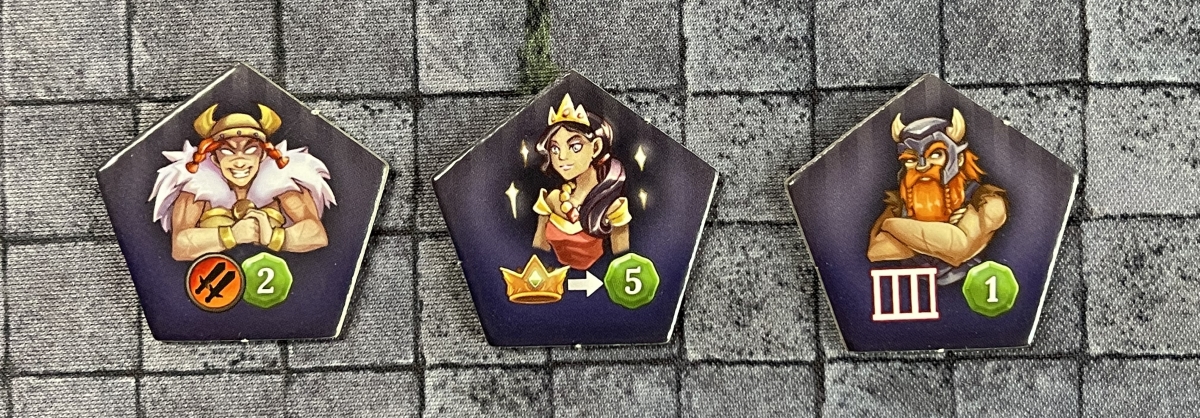
Of course, as this is a deckbuilding game, you’ll find all sorts of different cards: 183 to be precise. The cards are all of good quality, and easily shuffled. Though, as you will be shuffling cards a lot, it never hurts to get sleeves for your game.

How to Play Clank! Catacombs
You can download a copy of the rulebook here.
The Goal
The goal of Clank! Catacombs is to retrieve an Artifact token and escape the dragon by returning to the crypt where you started, accumulating enough points along the way to beat your fellow adventurers.

Setup
Place the Clank! board to one side of the playing area, with the Dragon marker on the space on the rage track that shows the number of players.
Shuffle the 22 blue Depths tiles, and place them in a face-down stack next to the Clank! board. Then shuffle the 6 purple Safety tiles. Select 2 at random and return them unseen to the game box, and place the remaining 4 face-down on top of the Depth tiles stack.
Add these items to the bank:
- Gold (in values of 1, 5, and 10)
- Lockpicks
- 5 white Ghost cubes
- Dragon bag, containing 24 black dragon cubes
- major secrets, minor secrets, and prisoners, all shuffled in individual face-down piles

Stack the seven artifacts in order of value with the 5-point artifact on top, and the 20-point artifact on the bottom. Add the stack to the bank area. Finally, add to the bank the Market Board. Place all the Market tokens on the board, with the three Crowns stacked so that the 10-point crown is on top, and the 8-point Crown is on the bottom.
Place the starting tile in the center of the play area, with either side face-up.

Place the three Monkey Idol tokens in the Monkey Shrine room, and the Mastery tokens above the crypt on the starting tile.
Create stacks of Mercenary, Explore, and Secret Tome cards, and place them on the other side of the table from the Clank! Board. These, along with the Goblin card, form the reserve.

Shuffle the Dungeon Deck, and deal out six cards face up to form the Dungeon Row. Note: if any of those cards show the Dragon Attack symbol, draw new cards to replace them. Shuffle those discarded cards back into the Dungeon Deck. Place the Dungeon Deck next to the Dungeon Row.
Each player chooses a color and takes the matching Clank! cubes and meeple. They place their meeple in the crypt on the starting tile.
Each player takes 3 lockpicks from the bank, as well as their starting deck that consists of 6 Burgles, 2 Stumbles, 1 Sidestep, and 1 Scramble. Players shuffle their starting deck and draw a hand of 5 cards.

The sneakiest player goes first, with play proceeding clockwise. The first player places 3 Clank! cubes in the Clank! area on the Clank! Board, the second player places 2 cubes, and the third and fourth players, if there are any, place 1 and 0 cubes respectively.
Gameplay
You always start your turn with 5 cards in hand. You must play all the cards in your hand, but in any order you choose. Cards will allow you to take various actions, to move around the board and accomplish your goals.

Some cards will also have you adding or removing Clank! from the Clank! Board, or give you gold, or let you draw cards, or interact in special ways with other cards or areas on the map.
The resources that your hand of cards generates will allow you to take the following actions:
Acquire a Card
The majority of the cards in the Reserve and the Dungeon Row are purchasable using Skill points. Purchasable cards in the Reserve have a gold banner, and purchasable cards in the Dungeon Row have a blue banner. The cost of each card appears in the lower right corner of the card. When you acquire a card, it immediately goes into your discard pile unless specific wording on the card indicates otherwise.
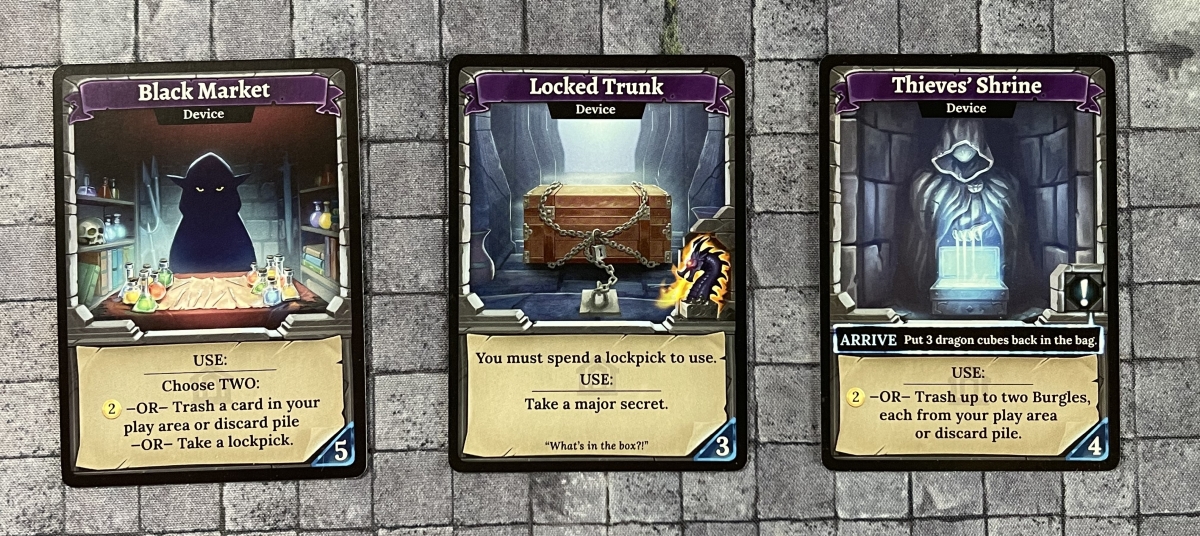
Use a Device
Cards with purple banners are devices. You also pay for these with skill points, but the cards are one-use items that go into the Dungeon Deck discard pile instead of your own.
Fight a Monster
Monsters have red banners, and you defeat them using swords. The swords in the lower right corner of the card indicates how many swords it requires to defeat them, and the card text indicates the reward for defeating them. Defeated monsters go into the Dungeon Deck discard pile. The Goblin, which is in the Reserve, can be defeated an unlimited number of times, and is never discarded. He’s basically a gold piñata.
Movement
Boots are used as resources for moving through the dungeon. All tunnels require at least one boot to move from room to room. Some tunnels will have a footprints symbol, which indicates that you must use an extra boot to move through that tunnel. If there are one or more monster symbols, then you must either spend a sword for each monster, or take a wound for any that you did not spend a sword on. And if you want to move through a tunnel with a lock symbol, you must place one of your lockpick symbols over the lock. That tunnel is now open for anyone for the rest of the game.
Some tunnels are one-way only, as indicated by an arrow on the tunnel. Should you acquire a Catacombs Map, which is one of the major secrets in the game, then you can move in any direction on one-way tunnels.
Buy From the Market
If you are in a Market room, you may buy any of the items from the Market board, each of which costs 7 gold. These are:
- Backpack- Allows you to carry a 2nd artifact. Also worth 5 points at end of game.
- Blood Amulet- Immediately heals 2 wounds, but must have at least 5 damage to purchase. Also worth 7 points at end of game.
- Burglar’s Kit- Immediately receive 2 lockpicks from the bank. Also worth 2 points at end of game.
- Crown – worth between 8-10 points at end of game.
Take an Artifact
If you’re in the room with an Artifact token, you may choose to take that Artifact. However, you may only ever carry one Artifact, unless you’ve purchased the Backpack from the Market. Whenever a player takes an Artifact, then you also move the Dragon Marker up one space on the Rage Track.
Pick a Chest, Library, or Prison
When you are in a room with one of those features, you may take one of your lockpicks and place it on the tile feature. You will then immediately gain the reward. Opening a Chest will reward players with a randomly-drawn Major Secret token, opening a Library will reward a Secret Tome card (worth 7 points at the end of the game), and opening a Prison will reward players with 2 Prisoner tokens.
Placing Tiles and Tile Features
If your move would take you off the current tile, you draw the top tile from the stack and then align the tile in any orientation to the side of your current one. The one stipulation is that you must have enough of a particular resource to legally allow your move onto that tile. For example, you can’t move through a locked tunnel if you don’t have a lockpick to spend on unlocking it.
There are several different features that may appear on a tile, as illustrated in the rulebook. In addition to the ones previously discussed, these are:
- Artifact – When that symbol appears on a tile that has just been placed, you take the top Artifact from the Artifact stack and place it on the indicated spot on the tile. The symbol may be accompanied by one or two “+” symbols, in which case you will take the second or third Artifact down from the top of the stack and place it.
- Crystal Cave – You must end all movement when entering these spaces, even if you still have boots available.
- Haunted Tiles – these tiles with ghosts on them require that you immediately add a Ghost cube from the Bank and place in in the Clank! area.
- Portal- allows you to step through to another portal anywhere on the map.
- Minor Secret – when you move into an area with the minor secret symbol, you immediately draw one of those tokens randomly from the bank.
- Monkey Idol – take one of the monkey idol tokens from the room and put it in your supply; it is worth 5 points at the end of the game.

- Gold – take as much gold from the bank as indicated by the number in the yellow circle.
- Healing – When you stop in a room with a heart, remove one of your cubes from the wound track.
- Wayshrines – You may take one of your cubes from your supply and place it in the corner of a wayshrine when you stop in one. You take 1 gold from the bank for each wayshrine you’ve placed your cubes in so far when you do including that one.

Ending Your Turn
Once you’ve played all your cards and taken all your actions, you clear your play area and draw a new hand of 5 cards. If you don’t have enough cards left in your deck to draw a full hand, shuffle your discard pile and deal out enough additional cards to bring you up to 5.
If you have purchased any cards from the Dungeon Row, you now replace them, drawing from the Dungeon Deck. If any cards that are dealt in the Dungeon Row have an exclamation mark and “Arrive” text, follow the directions printed on the card. And if any cards show a dragon symbol, then the dragon attacks.
Dragon Attack
Take all of the cubes in the Clank! area and place them in the Dragon Bag. Shake the bag, and then draw as many cubes as there are shown at the Dragon Marker’s current position.
Black dragon cubes are placed aside, and have no effect. If a player’s colored cube is drawn, it is placed onto their wound track. And if a white Ghost cube is drawn, then each player takes a cube from their supply and adds it to their own wound track. The white cube is then placed back into the Clank! area, to be drawn again on the next dragon attack.
If the Dragon Bag is ever empty after an attack, then the game ends immediately and all remaining players are knocked out.

Game End
The game ends when all players have either escaped or been knocked out.
You escape when you make your way back to the Crypt with an Artifact. At that point, you finish the rest of your turn, then remove your pawn from the board. You also gain a Mastery token, which is worth an additional 20 points.
You are knocked out when you take a final wound, as helpfully indicated by the skull in the final position. You lay your pawn on its side, and if you don’t have an artifact or your meeple is on a Depths tile, then you will score 0 points. If you are knocked out but have an artifact and are on one of the safe tiles, you will still score at the end of the game; you just won’t get a Mastery token.
If you are knocked out and the game is not yet over, then on your turn you will take all the cubes from the Clank! area and add them to the Dragon Bag, then draw 4 cubes (or 6 cubes in a 2-player game) as if it were a dragon attack. Knocked out players do not take wounds if their cubes are drawn.
Scoring
Once all the player have escaped or been knocked out, you then move onto scoring. For any eligible players, you add up: the value of your artifacts, points for any tokens acquired, points that show on any cards in their deck that have numbers on the top right corners, and points equal to any gold in their possession. Whoever has the most gold is declared The Greatest Thief in the Realm! If there is a tie, the player with the most valuable artifact wins.
Clank! Catacombs is a 2022 GeekDad Game of the Year Finalist!
Why You Should Play Clank! Catacombs
While this is the first Clank! game that I’ve personally reviewed for GeekDad, I’m certainly a fan of the series. I own a well-played copy of Clank! In! Space!, and earlier this year I finally had a chance to play about half of the campaign of Clank!: Legacy – Acquisitions Incorporated. I like designer Paul Dennen’s games; he was also the brainchild behind 2021 GeekDad Game of the Year Dune: Imperium.
However, when reviewing a game, I’m not looking at the designer’s pedigree. I’m looking at the game itself: how well it plays, how it looks on the table, and that one hard to define but oh so important feature- how much I want to play it again.
And why bury the lede? I very much want to play Clank! Catacombs again.
I enjoy deck building games, and the Clank! series marries theme with gameplay in a satisfying manner. You feel like an adventurer, racing through the big bad’s lair to steal their treasure before they can destroy you for your thievery.

But with Clank! Catacombs, for the first time you truly get an exploration aspect to your gameplay. In previous games, you have the entire board laid out for you at the beginning of the game, so you can see all possible routes, as well as where all of the artifacts are. People who played those games over and over would often figure out optimized routes that they would follow each game.
But now, you get a different dungeon every time you play. Not only do you take out two of the tiles during setup, but the order of the tiles is random, and placement depends entirely on whose turn it is when a tile is drawn. And as I said before, there may be times during the game where certain tiles will change their orientation, possibly upending the carefully though-out path you were planning to reach a certain room. The only thing you can be sure of, is that the deeper you go in the dungeon, the more valuable the artifacts you will find.
A nice benefit of switching from a static board to tiles is the setup of the game. With other games in the series, you’d lay out the board, and then place all of the Artifacts and major and minor secrets. Now, the Artifacts only get placed when a tile with an Artifact symbol comes out. Players draw a minor secret from the bank when they enter a room with a question mark on it, or draw a major secret when they unlock a chest. All of this makes it much faster to get the game to the table, which is always a boon on a game night.
There’s a great risk/reward aspect to the Clank! series. Clank! Catacombs provides even more ways to earn points, with its unlockable chests, libraries, and prisons. But if you spend too many of your lockpicks going for those points, you may not be able to navigate around the dungeon later. And while you can find other lockpicks during the game, it’s not always going to be easy to find them. So you need to carefully plan when best to use them.
I especially like the introduction of the prisoners. It’s not uncommon in Dungeons & Dragons to find non-player characters locked away in a dungeon, and so it’s nice thematically to see them incorporated here. Much like with secrets, drawing prisoners is a random selection. You might find some of the prisoners more useful than others, especially depending on whether you’ve got certain other items in your possession. I kept hoping I’d find and rescue a Sorceress, who gives you 5 points at the end of the game if you have at least two Secret Tomes (which, of course, I had).

Clank! Catacombs doesn’t reinvent the wheel. If you’ve played previous entries in the series, much of the gameplay will feel familiar.
But what Clank! Catacombs does, and does very well, is give you both an evolution and a refinement of the series’ gameplay. Paul Dennen has taken some of the best elements from previous Clank! games, such as the ghosts from Clank!: Legacy, and wedded them with fresh features like the prisoners and the random dungeon tiles.
For me, Clank! Catacombs is now my go-to game in the Clank! universe. It provides immensely satisfying gameplay, wrapped in a visually-appealing package. And even though it’s a standalone game, it is still compatible with cards from previous Clank! expansions, so you can mix and match for even more gameplay variety if you choose. There is even a page of rules in the rulebook specifically for incorporating Clank! Adventuring Party, an expansion that allows you to add a fifth and sixth player to the game.
If you’re a fan of the Clank! series of games, you’ll definitely want to pick up Clank! Catacombs. And if you’re a newcomer to deck building, this would be a fantastic introduction to the genre. Either way, Clank! Catacombs will provide you with hours and hours of dungeon-delving, deck building fun. I highly recommend it.
For more information, head to the Dire Wolf website.
Click here to see all our tabletop game reviews.
![]() To subscribe to GeekDad’s tabletop gaming coverage, please copy this link and add it to your RSS reader.
To subscribe to GeekDad’s tabletop gaming coverage, please copy this link and add it to your RSS reader.
Disclosure: GeekDad received a copy of this game for review purposes.
